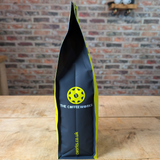Notes of milk chocolate and hazelnuts balanced with a fruity acidity, lovely easy drinking coffee.
This is a lovely, fruity blend made from two high quality speciality beans, Brazilian Mió Lot 1930 & Monte Santo de Minas & Costa Rican La Trinidad.
Brazilian Mió Lot 1930 is a red honey processed coffee, grown at an altitude of 1,100m, Yellow Catucaí, with an SCA Score of 84.5.
Costa Rican La Trinidad is a washed coffee grown at 1800-1900m, Caturra and Catuai with an SCA Score of 85.
Please keep in mind, where espresso is concerned, that this isn't a blend in the traditional sense of the word.
This is a medium roast blend of two speciality single origin coffees. It's great for espresso if well dialled in, but it's a bit of a challenge.
If you're looking for more forgiving, easier to dial in blends, you'd be better off with more traditional espresso blends.

How it Tastes
This is a blend of two high quality single origin speciality coffees which have been specifically blended to produce a super tasty but easy drinking coffee with notes of choc & nut.
Fazenda Mio & Tarrazú Co-op
The Tarrazú Co-op is situated in the La Trinidad micro-zone in the famous Tarrazu region of Sul de Minas in the south of Minas Gerais state, Brazil.
Founded in 1960, Tarrazú cooperative now boasts approximately 5,000 members, but incredibly it is still run by the farmers! Tarrazú is widely regarded as one of the leading cooperatives in Costa Rica.
Mió is a family-owned (the Pellicer family) coffee farm in Monte Santo de Minas in Brazil, who refused to give in to defeat, and started from scratch after the catastrophic frosts of 1975 which destroyed roughly half of Brazil's coffee trees!
It took them over 10 years, but they finally managed to start again, beginning with a tiny plot of land and just 6 coffee trees!
Now, Fazenda Mió is one of the major producers in the area, and the farm spans almost 1600 hectares between Southern Minas Gerais and the Mogiana highlands. This is a producer dedicated to preserving the local biodiversity, in fact much of their land is left as untouched, natural native forest.







